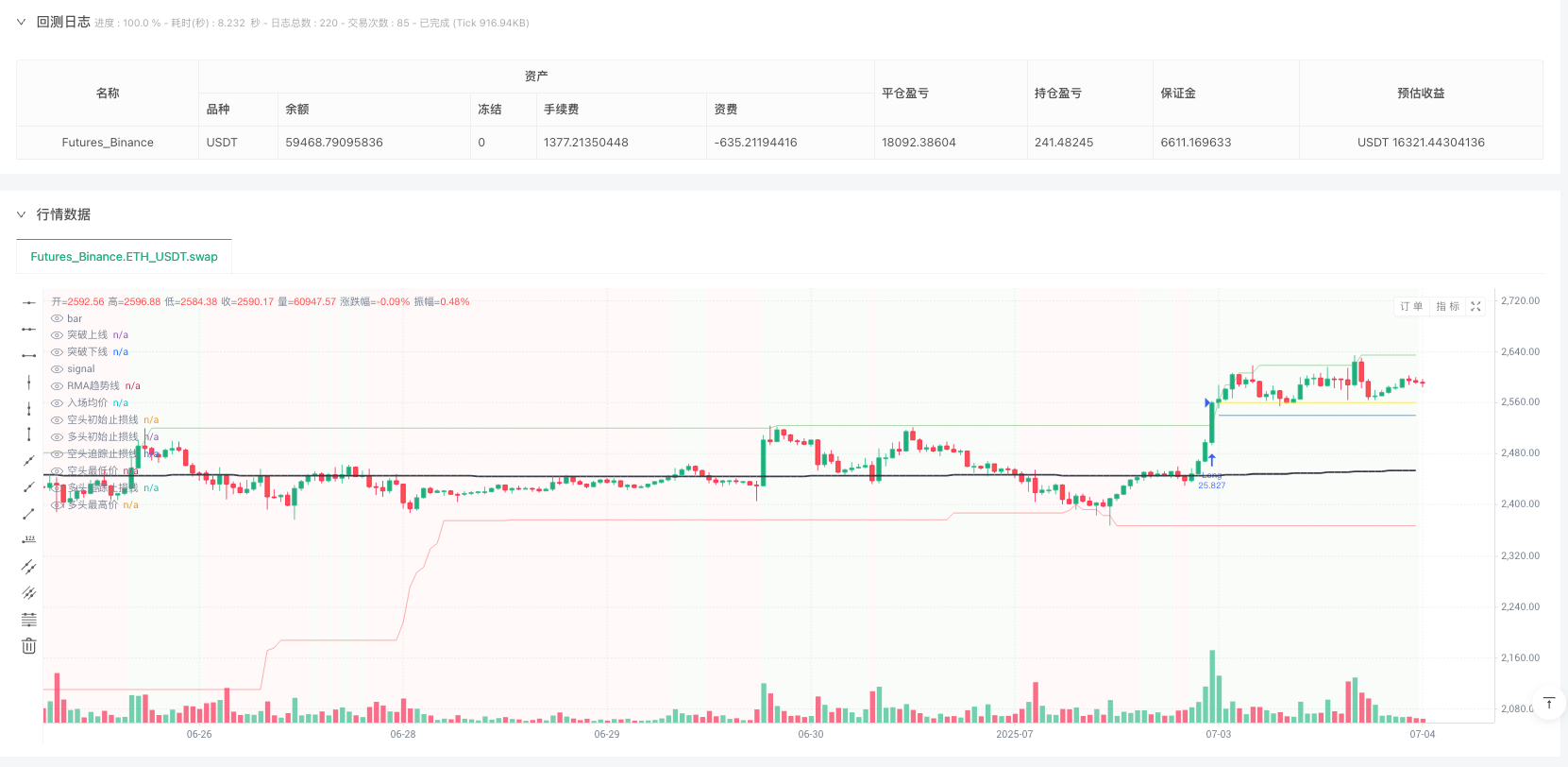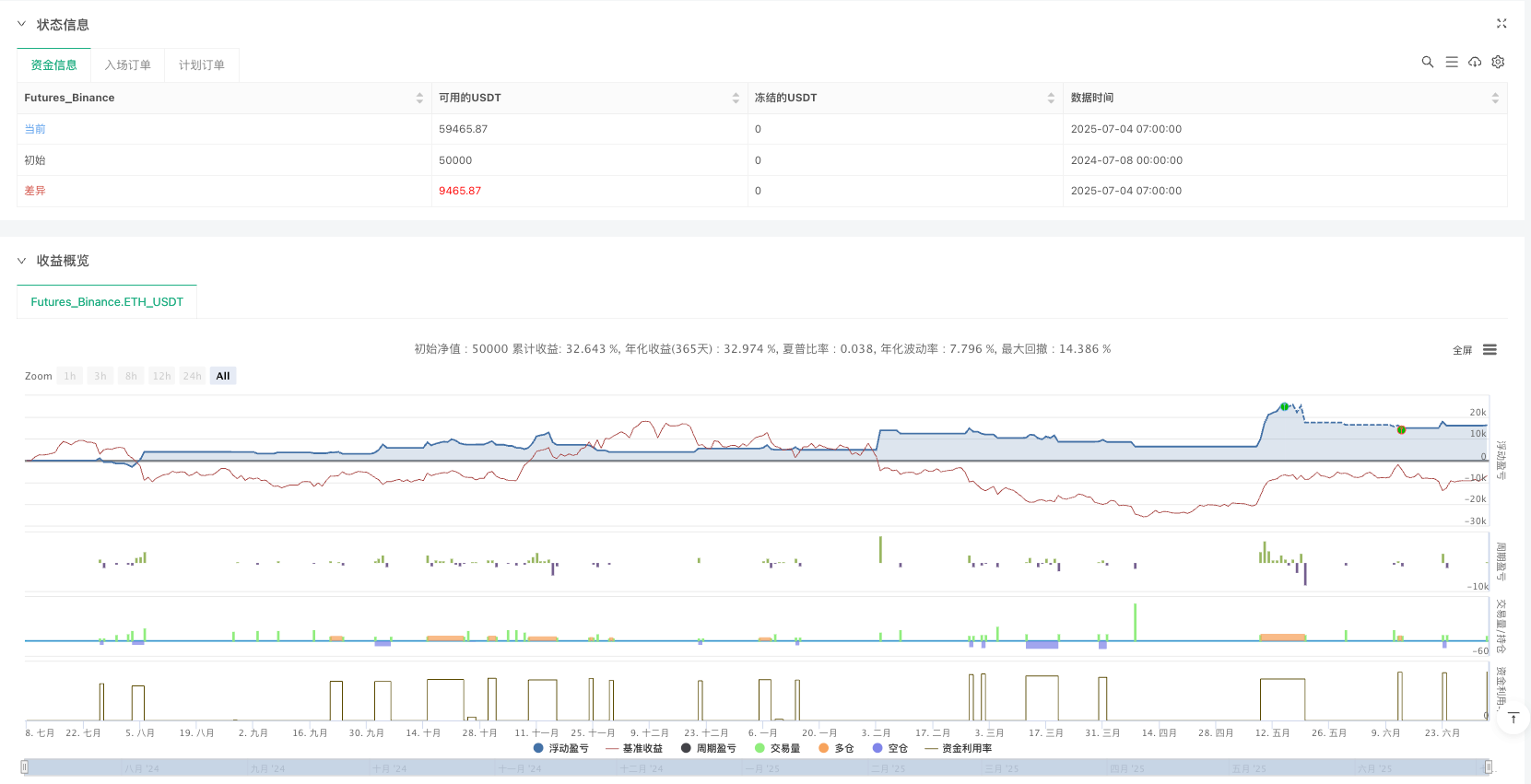

概述
该策略是一个精心设计的突破交易系统,结合了ATR(平均真实波幅)自适应止损管理与ADX(平均方向指数)方向过滤功能。策略在N周期高点/低点突破确认后进入交易,同时参考长期RMA(滚动移动平均线)趋势过滤器确保与主趋势保持一致。系统采用双阶段止损逻辑:初始固定ATR止损和达到利润阈值后的动态追踪止损,并通过回撤止盈机制锁定波动性较大时期的利润。
策略原理
该策略的核心原理基于价格突破历史支撑阻力位结合趋势确认和方向强度过滤的综合判断系统:
突破信号生成:使用N周期(默认96)高点/低点作为突破参考点,当价格收盘突破前期高点且处于上升趋势时,触发多头信号;当价格收盘突破前期低点且处于下降趋势时,触发空头信号。
趋势过滤:采用较长周期(默认960)的RMA均线作为趋势判断依据,价格在RMA上方视为上升趋势,价格在RMA下方视为下降趋势,确保交易方向与主趋势一致。
ADX方向强度过滤:通过计算当前市场的方向性强度(ADX指标),并要求ADX大于设定阈值(默认12)且处于上升阶段,过滤掉方向性不明确的盘整市场环境。
双阶段止损机制:
- 第一阶段:入场后使用ATR乘数(默认1.0)设置初始止损位置
- 第二阶段:当利润达到ATR乘数(默认3.0)倍时,激活追踪止损,使用更大的ATR乘数(默认9.0)设置动态止损位置
回撤止盈机制:在追踪止损激活后,记录多头最高价/空头最低价,当价格从极值点回撤超过设定的ATR倍数(多头默认13倍,空头默认4倍)时,触发止盈平仓。
策略优势
自适应风险管理:通过ATR指标动态调整止损位置,使策略在不同波动率环境下都能有效控制风险。ATR作为波动率指标,能够根据市场实际波动情况自动调整止损距离,避免了固定点数止损在不同市场条件下过宽或过窄的问题。
多层次风险控制:策略采用初始止损与追踪止损相结合的双层止损逻辑,既保证了初始风险可控,又能在盈利扩大后锁定利润并给予趋势充分发展空间。这种止损结构特别适合捕捉大趋势行情。
方向性确认过滤:通过ADX指标过滤,要求市场具备足够的方向性且方向性正在增强(ADX>阈值且ADX>ADX[1]),有效避免了在无明显趋势的盘整市场中频繁交易,减少了假突破带来的亏损。
趋势一致性保障:使用长周期RMA均线作为趋势过滤器,确保只在主趋势方向上交易,避免逆势操作,提高了交易成功率和资金效率。
智能止盈机制:通过回撤止盈功能,在价格大幅波动后出现回调时及时锁定利润,避免利润过度回吐,尤其适合捕捉波动率突然扩大的行情。
可视化监控:策略在图表上清晰标识入场价位、各类止损线、突破水平以及趋势背景色,使交易者能够直观监控策略运行状态和关键价位。
策略风险
假突破风险:尽管使用了ADX过滤和趋势确认,市场仍可能出现假突破情况,特别是在重要新闻发布或流动性突然变化时。解决方法是适当提高ADX阈值或增加突破确认要求,如要求突破后持续多个K线维持在突破水平上方/下方。
参数敏感性:策略性能对参数设置较为敏感,特别是ATR周期、乘数以及突破周期的选择。不同市场环境下最优参数可能存在较大差异。建议通过历史回测在不同市场环境下验证参数稳定性,并考虑实施自适应参数调整机制。
追踪止损滞后性:在剧烈行情反转时,追踪止损可能无法及时跟上价格变化,导致已获利润部分回吐。可以考虑在高波动性环境中动态调整ATR乘数或结合短期动量指标提前预警可能的趋势反转。
长周期趋势过滤滞后:使用长周期RMA均线作为趋势过滤可能导致在趋势转折点附近错过信号或产生错误信号。解决方案是引入多周期趋势确认或结合更灵敏的中短期趋势指标作为辅助判断。
回撤止盈过早退出:在强势趋势中,回撤止盈机制可能导致过早退出仍将继续发展的趋势。可以考虑根据趋势强度动态调整回撤阈值,或结合波动率变化情况自适应调整回撤倍数。
优化方向
自适应参数体系:构建基于市场波动率和趋势强度的自适应参数调整机制,使ATR乘数、ADX阈值和回撤倍数能够根据当前市场环境自动优化。例如,在低波动环境中减小ATR乘数,在高波动环境中增加ATR乘数;在强趋势中提高回撤倍数,在弱趋势中降低回撤倍数。
多时间框架确认:引入多时间框架分析,要求更高时间框架的趋势方向与交易方向一致,并将较高时间框架的支撑阻力位纳入决策参考,提高突破信号的可靠性。
智能入场优化:实现分批入场机制,在初始突破信号触发后部分入场,在突破得到进一步确认后加仓,降低假突破带来的风险同时保证不错过真实突破行情。
波动率感知止盈:开发基于波动率变化的智能止盈系统,在波动率突然扩大后设置更严格的回撤止盈条件,在波动率稳定时给予价格更大的回调空间,使止盈决策更符合市场实际状态。
机器学习增强:引入机器学习算法对历史突破模式进行分析,识别高成功率突破的特征组合,并据此动态调整策略参数或设置突破质量评分系统,优先选择高质量突破信号交易。
交易成本优化:针对不同交易品种的流动性特点和交易成本结构,优化入场时机和订单类型,如在低流动性环境中采用限价单代替市价单,或在高波动性环境中采用追踪限价单(Trailing Limit Order)进行入场。
情绪指标整合:结合市场情绪指标(如波动率指数、市场广度指标等)作为辅助决策参考,在极端情绪环境下调整策略参数或暂停交易,避免在非理性市场环境中遭受不必要的损失。
总结
高精度ATR追踪止损突破策略与ADX方向过滤系统是一个结合了技术分析多种核心理念的综合交易系统。它通过突破交易捕捉趋势起点,利用趋势过滤和方向强度确认提高信号质量,并通过自适应风险管理和多层次止损止盈机制实现全面的资金管理。
该策略最大的优势在于其对不同市场环境的适应性和完善的风险管理框架。通过ATR指标实现的动态风险调整使策略能够在不同波动率环境下保持相对一致的风险暴露水平,而双阶段止损和回撤止盈机制则提供了兼顾资金保护和利润最大化的平衡解决方案。
虽然策略在参数敏感性和止损滞后性等方面存在一定风险,但通过建议的优化方向,特别是自适应参数体系和多时间框架确认,这些风险可以得到有效控制。进一步引入机器学习和情绪指标分析则有望显著提升策略的稳健性和长期收益潜力。
对于量化交易者而言,这一策略提供了一个坚实的框架,可以根据个人风险偏好和市场观点进行灵活调整和扩展,是一个兼具理论深度和实用价值的交易系统。
/*backtest
start: 2024-07-08 00:00:00
end: 2025-07-04 08:00:00
period: 1h
basePeriod: 1h
exchanges: [{"eid":"Futures_Binance","currency":"ETH_USDT"}]
*/
//@version=6
strategy('YTPBTC1HATRSSADX',
overlay=true,
initial_capital=10000,
commission_value=0.1,
default_qty_value=100,
default_qty_type=strategy.percent_of_equity,
margin_long=10,
margin_short=10,
pyramiding=1)
// ==================== 输入参数 ====================
atr_length = input.int(48, 'ATR周期', minval=1, step=12)
atr_mult_1 = input.float(1.0, 'ATR初始止损乘数', minval=0.1, step=0.1)
atr_mult_2 = input.float(9.0, 'ATR追踪止损乘数', minval=0.1)
// 追踪激活倍数
profit_atr_mult = input.float(3.0, 'ATR追踪激活倍数', minval=0.5, step=0.5)
// 固定回撤止盈设置
long_pullback_atr = input.float(13, '多头回撤止盈倍数', minval=0, step=1)
short_pullback_atr = input.float(4, '空头回撤止盈倍数', minval=0, step=1)
breakout_period = input.int(96, title='突破周期', minval=1, step=24)
rma_length = input.int(500, 'RMA趋势过滤周期', minval=1, step=96)
// ADX设置
enable_adx_filter = input.bool(true, '启用ADX过滤')
adx_length = atr_length//input.int(48, 'ADX周期', minval=1, step=12)
adx_threshold = input.float(12, "ADX阈值", minval=1)
use_breakeven = true // 启动追踪时是否先保本止损
// ==================== ATR计算 ====================
atr_value = ta.atr(atr_length)
// ==================== ADX指标计算 ====================
// 真实波幅计算
tr = math.max(math.max(high - low, math.abs(high - nz(close[1]))),
math.abs(low - nz(close[1])))
// 方向性移动计算
dm_plus = high - nz(high[1]) > nz(low[1]) - low ? math.max(high - nz(high[1]), 0) : 0
dm_minus = nz(low[1]) - low > high - nz(high[1]) ? math.max(nz(low[1]) - low, 0) : 0
// ADX计算
var float sm_tr = na
var float sm_dm_plus = na
var float sm_dm_minus = na
sm_tr := nz(sm_tr[1]) - nz(sm_tr[1]) / adx_length + tr
sm_dm_plus := nz(sm_dm_plus[1]) - nz(sm_dm_plus[1]) / adx_length + dm_plus
sm_dm_minus := nz(sm_dm_minus[1]) - nz(sm_dm_minus[1]) / adx_length + dm_minus
di_plus = sm_dm_plus / sm_tr * 100
di_minus = sm_dm_minus / sm_tr * 100
dx = math.abs(di_plus - di_minus) / (di_plus + di_minus) * 100
adx = ta.sma(dx, adx_length)
// ==================== 趋势过滤 ====================
rma_trend = ta.rma(close, rma_length)
plot(rma_trend, title='RMA趋势线', color=color.black, linewidth=2)
trend_long = close > rma_trend
trend_short = close < rma_trend
// ==================== 突破信号 ====================
// 获取过去N根K线的最高高点和最低低点(避免未来数据)
highest_high = ta.highest(high, breakout_period)[1]
lowest_low = ta.lowest(low, breakout_period)[1]
// 入场条件 - 修改ADX条件,要求ADX上升
adx_condition = not enable_adx_filter or (adx >= adx_threshold and adx > adx[1])
long_condition = close > highest_high and trend_long and strategy.position_size == 0 and adx_condition
short_condition = close < lowest_low and trend_short and strategy.position_size == 0 and adx_condition
// ==================== 入场执行 ====================
if long_condition
strategy.entry('Long', strategy.long)
if short_condition
strategy.entry('Short', strategy.short)
// ==================== ATR止损系统 ====================
// 止损状态变量
var float long_stop_initial = na // 第一段初始止损
var float long_stop_trail = na // 第二段追踪止损
var bool long_trail_active = false
var float short_stop_initial = na // 第一段初始止损
var float short_stop_trail = na // 第二段追踪止损
var bool short_trail_active = false
// 回撤止盈变量
var float long_highest = na // 多头最高价记录
var float short_lowest = na // 空头最低价记录
// ==================== 多头止损计算 ====================
if strategy.position_size > 0
// 新开多头仓位
if strategy.position_size[1] <= 0
long_stop_initial := strategy.position_avg_price - atr_value * atr_mult_1
long_stop_trail := na
long_trail_active := false
long_highest := na // 重置最高价记录
else
// 计算当前浮动盈亏
float current_profit = close - strategy.position_avg_price
// 检查是否激活追踪止损
if not long_trail_active and current_profit >= atr_value * profit_atr_mult
long_trail_active := true
long_highest := high // 开始记录最高价
// 保本处理
if use_breakeven
long_stop_trail := strategy.position_avg_price
else
long_stop_trail := close - atr_value * atr_mult_2
// 更新追踪止损和最高价记录
if long_trail_active
// 更新最高价记录
long_highest := math.max(long_highest, high)
// 传统追踪止损更新
float new_stop = close - atr_value * atr_mult_2
long_stop_trail := math.max(long_stop_trail, new_stop)
// ==================== 空头止损计算 ====================
if strategy.position_size < 0
// 新开空头仓位
if strategy.position_size[1] >= 0
short_stop_initial := strategy.position_avg_price + atr_value * atr_mult_1
short_stop_trail := na
short_trail_active := false
short_lowest := na // 重置最低价记录
else
// 计算当前浮动盈亏
float current_profit = strategy.position_avg_price - close
// 检查是否激活追踪止损
if not short_trail_active and current_profit >= atr_value * profit_atr_mult
short_trail_active := true
short_lowest := low // 开始记录最低价
// 保本处理
if use_breakeven
short_stop_trail := strategy.position_avg_price
else
short_stop_trail := close + atr_value * atr_mult_2
// 更新追踪止损和最低价记录
if short_trail_active
// 更新最低价记录
short_lowest := math.min(short_lowest, low)
// 传统追踪止损更新
float new_stop = close + atr_value * atr_mult_2
short_stop_trail := math.min(short_stop_trail, new_stop)
// ==================== 止损执行 ====================
// 第一段止损:收盘价止损(未激活追踪时)
if strategy.position_size > 0 and not long_trail_active
// 检查收盘价是否触及初始止损线
if close <= long_stop_initial
strategy.close('Long', comment='初始止损')
if strategy.position_size < 0 and not short_trail_active
// 检查收盘价是否触及初始止损线
if close >= short_stop_initial
strategy.close('Short', comment='初始止损')
// 第二段止损:实时止损(激活追踪后)
if strategy.position_size > 0 and long_trail_active
strategy.exit('Long Trail Stop', from_entry='Long', stop=long_stop_trail)
if strategy.position_size < 0 and short_trail_active
strategy.exit('Short Trail Stop', from_entry='Short', stop=short_stop_trail)
// 动态回撤止盈检查
if strategy.position_size > 0 and long_trail_active and not na(long_highest)
// 计算从最高点回撤幅度
pullback_amount = long_highest - close
pullback_threshold = atr_value * long_pullback_atr
if pullback_amount >= pullback_threshold
strategy.close('Long', comment='回撤止盈')
if strategy.position_size < 0 and short_trail_active and not na(short_lowest)
// 计算从最低点反弹幅度
pullback_amount = close - short_lowest
pullback_threshold = atr_value * short_pullback_atr
if pullback_amount >= pullback_threshold
strategy.close('Short', comment='回撤止盈')
// ==================== 变量重置 ====================
if strategy.position_size[1] != 0 and strategy.position_size == 0
long_stop_initial := na
long_stop_trail := na
long_trail_active := false
short_stop_initial := na
short_stop_trail := na
short_trail_active := false
// 重置回撤止盈变量
long_highest := na
short_lowest := na
// ==================== 图表绘制 ====================
plot(strategy.position_avg_price, color=color.new(color.yellow, 44), title="入场均价", linewidth=1)
plot(long_stop_initial, color=color.new(color.blue, 44), title='多头初始止损线', linewidth=1)
plot(short_stop_initial, color=color.new(color.blue, 44), title='空头初始止损线', linewidth=1)
plot(long_stop_trail, color=color.new(color.fuchsia, 44), title='多头追踪止损线', linewidth=1)
plot(short_stop_trail, color=color.new(color.fuchsia, 44), title='空头追踪止损线', linewidth=1)
// 最高/最低价记录线
plot(long_highest, color=color.new(color.green, 70), title='多头最高价', linewidth=1, style=plot.style_stepline)
plot(short_lowest, color=color.new(color.red, 70), title='空头最低价', linewidth=1, style=plot.style_stepline)
// 绘制突破线
plot(highest_high, color=color.new(color.green, 70), title='突破上线')
plot(lowest_low, color=color.new(color.red, 70), title='突破下线')
// 背景颜色显示趋势
bgcolor(trend_long ? color.new(color.green, 95) : trend_short ? color.new(color.red, 95) : na, title="趋势背景")
// ==================== 信息显示 ====================
// 在图表上显示当前策略信息
base_rows = enable_adx_filter ? 3 : 2
var table info_table = table.new(position.top_right, 2, base_rows, bgcolor=color.white, border_width=1)
var int row_index = 0
row_index := 0 // 重置行索引
table.cell(info_table, 0, row_index, "ATR周期", text_color=color.black, text_size=size.small)
table.cell(info_table, 1, row_index, str.tostring(atr_length), text_color=color.black, text_size=size.small)
row_index := row_index + 1
// 只在启用ADX时显示
if enable_adx_filter
table.cell(info_table, 0, row_index, "ADX", text_color=color.black, text_size=size.small)
table.cell(info_table, 1, row_index, str.tostring(math.round(adx, 1)), text_color=color.black, text_size=size.small)
row_index := row_index + 1
table.cell(info_table, 0, row_index, "追踪倍数", text_color=color.black, text_size=size.small)
table.cell(info_table, 1, row_index, str.tostring(profit_atr_mult), text_color=color.black, text_size=size.small)